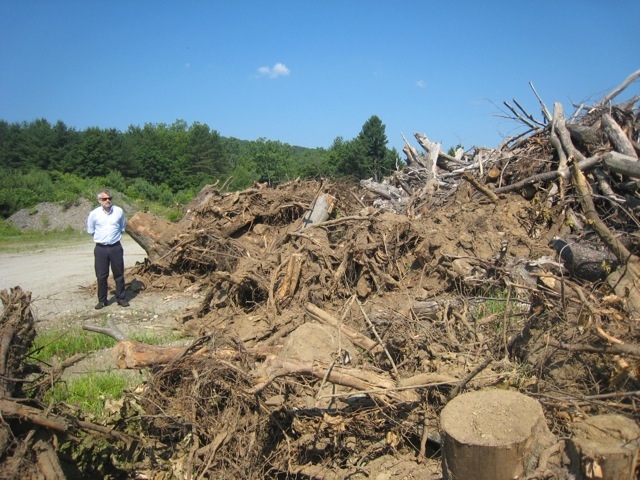
In the wake of Tropical Storm Irene, towns did what they could to prevent further flooding, including hauling away trees and boulders that were clogging streams. But some small towns say, now, they’re stuck with some big bills.
In the days following Irene, Vermont towns were frantic to prevent further destruction. Some pulled whole forests out of its rivers.
Rockingham Municipal Manager Tim Cullenen is dwarfed by a giant jumble of huge tree stumps, root balls and tree trunks stored at the town’s gravel pit.
"This is just one of several wood debris piles," said Cullenen. "I’m not even sure ‘pile’ actually describes it properly."
This pile is nearly 15 feet high with a footprint bigger than a pro basketball court.
A few miles away, standing on the banks of the Saxtons River, Cullenen says the town had to remove not only trees, but rocks that formed a bottleneck here right after the flood
"I mean this was clogged," said Cullenen. "And our rationale was the next time there’s a big water event — not necessarily another hurricane or a 500-year flood – just winter runoff, this was going to create a natural barrier."
A barrier that could dam the river and cause it to flood again.
The town had already lost three homes and a covered bridge. It cost Rockingham more than $465,000 to remove the rocks and trees. FEMA reimbursed $19,000. Cullenen says the town has had different answers from different FEMA staffers about the rest.
"We’ve had some people say, ‘Yup, it’s going to be covered,’ " said Cullenen. "The next guy comes in and says, ‘Ahh, I’m not sure.’ The next one says, ‘No we’re not doing that.’ "
FEMA says it plans to review Rockingham’s case again.
About 60 miles southwest of here, Bennington is hoping for reimbursement for an even heftier bill.
"Between four and four-and-a-half million dollars," said Bennington Planning Director Dan Monks.
Standing above the Roaring Branch of the Walloomsac River he points out how bare it is, like a moonscape with no trees. Irene tore out a thick forest that used to line its banks. Monks says after Irene there were so many trees and rocks piled in the river the water couldn’t move.
"Gravel, large and small stones that was brought down from the mountains and deposited here in the valley," recalled Monks. "It basically filled up this channel and clogged a three and a half mile stretch of river right in the center of our town."
About 10 days after Irene, Tropical Storm Lee was in the forecast. Monks says the sediment had to be removed to protect property and people. But before Bennington hauled it away the town hired a river scientist and worked with the state to develop a plan to remove the rocks. But all that planning hasn’t garnered a penny in FEMA reimbursement.
"We continue to get answers like, ‘We’re looking into it. We’ll get back to you. We need more information,’" said Monks. "But despite our repeated efforts, we have not gotten a decision regarding eligibility."
Timothy Barnett, FEMA’s public assistance officer, says debris removal can be eligible for FEMA funds when it eliminates threat to life, public health and safety. But he also says other federal agencies may be responsible.
"It could be the United States Army Corps of Engineers," said Barnett. "It could also be the responsibility of the Natural Resources Conservation Service. It is known as NRCS or FEMA. So we all have and can play a role in the debris removal in particular stream."
The small town of Woodford, next to Bennington, has a population of 400. But it spent more than $400,000 on debris removal. FEMA reimbursed part of it and told Woodford the Natural Resources Conservation Service might be responsible for the rest. But NRCS says no.
Timothy Barnett of FEMA says any lack of reimbursement isn’t because of a tight budget.
"Money is definitely not the issue," said Barnett.
One issue for FEMA is proper documentation. Another is figuring out which federal agency should pay. But Congressman Peter Welch says according to FEMA regulations, it can reimburse.
"FEMA does have the discretion," said Welch. "And there is money available, so my goal is to help these towns get the FEMA relief that they need and the law allows!"
Vermont is also advocating on behalf of these towns. Dan Monks of Bennington says it’s frustrating because his town tried to do it right.
"We didn’t just go in here and remove what we thought was the right amount," said Monks. "We actually had a plan that the river scientists developed for us, the state of Vermont approved and we executed. That is well beyond what should be expected of any town after a disaster."
FEMA says it is reviewing the matter, but the agency hasn’t set a deadline to resolve it.